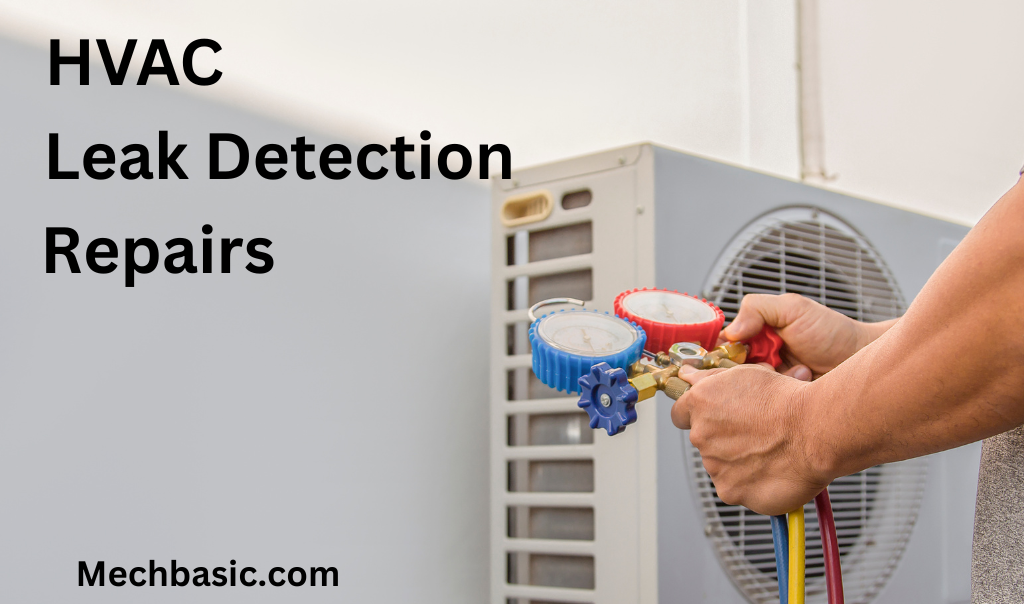Refrigerant leaks in HVAC systems can cause poor cooling performance, increased energy costs, and environmental harm.
Detecting and repairing leaks promptly is crucial for system efficiency and compliance with EPA regulations.

In this article:
What is a Refrigerant Leak in HVAC?
A refrigerant leak in an HVAC system occurs when the chemical coolant escapes from the coils or lines due to cracks, corrosion, or loose connections. This reduces the system’s ability to cool efficiently and can cause long-term damage if not repaired.
1. Signs of a Refrigerant Leak:
- 🔹 Weak cooling or heating performance
- 🔹 Higher energy bills (compressor working harder)
- 🔹 Frozen evaporator coil (due to low refrigerant levels)
- 🔹 Hissing or bubbling sounds (indicating a leak)
- 🔹 Oil stains around refrigerant lines or connections
2. Methods for Leak Detection:
A. Visual Inspection
- ✔ Check for oil stains or corrosion on refrigerant lines, coils, and fittings.
- ✔ Inspect flare connections, Schrader valves, and soldered joints.
B. Soap Bubble Test
- ✔ Apply soapy water to suspected leak areas.
- ✔ If bubbles form, it indicates escaping refrigerant.
- ✔ Best for small leaks in accessible areas.
C. Electronic Leak Detector (Sniffer)
- ✔ Handheld electronic detectors sense refrigerant vapors.
- ✔ Move the probe around coil joints, Schrader valves, and service ports.
- ✔ Ideal for quick detection of small leaks.
Also Read: How to find Refrigerant Leaks using Electronic Leak Detector.
D. Ultraviolet (UV) Dye Test
- ✔ Add UV dye to the refrigerant system.
- ✔ Run the system, then inspect with a UV light.
- ✔ Great for detecting leaks in hidden or hard-to-reach areas.
E. Nitrogen Pressure Test
- ✔ Remove refrigerant & pressurize system with dry nitrogen (250-500 psi).
- ✔ Listen for hissing sounds or use bubble solution.
- ✔ Effective for larger leaks or when system is empty.
F. Ultrasonic Leak Detection
- ✔ Uses a special microphone to detect ultrasonic frequencies from gas escaping.
- ✔ Useful for high-pressure leaks in noisy environments.
3. Repairing a Refrigerant Leak:
A. Common Leak Locations & Fixes
| Leak Location | Repair Method |
|---|---|
| Flare fittings | Tighten fitting or use thread sealant |
| Copper tubing pinholes | Brazing or epoxy sealant |
| Schrader valve core | Replace valve core |
| Evaporator/condenser coil leaks | Coil replacement or aluminum epoxy repair |
| Compressor connections | Re-solder or tighten joints |
B. Step-by-Step Leak Repair Process
- 1️⃣ Recover refrigerant safely (per EPA regulations).
- 2️⃣ Pressurize the system with nitrogen for further leak detection.
- 3️⃣ Repair or replace the leaking component.
- 4️⃣ Perform a vacuum test (pull system to <500 microns).
- 5️⃣ Recharge system with correct refrigerant type & amount.
- 6️⃣ Test system operation & verify superheat/subcooling.
4. Preventing Future Leaks
- ✅ Regular maintenance (inspect coils, fittings, and refrigerant levels).
- ✅ Use proper brazing techniques to prevent joint leaks.
- ✅ Ensure correct refrigerant charge (overcharging can cause leaks).
- ✅ Install vibration dampeners to reduce metal fatigue.
- ✅ Replace old copper tubing with corrosion-resistant materials.
Top Frequently Asked Questions:
1. What is refrigerant leak detection in HVAC?
🔧 Answer: It’s the process of finding where refrigerant is escaping from your HVAC system, typically in coils, lines, or connections.
2. How can I tell if my HVAC has a refrigerant leak?
🔧 Answer: Common signs include reduced cooling, hissing sounds, ice on the coils, and higher energy bills.
3. Is a refrigerant leak dangerous?
🔧 Answer: Yes—prolonged exposure can be harmful, and it can damage your system or reduce indoor air quality.
4. What tools are used to detect HVAC leaks?
🔧 Answer: Technicians use electronic leak detectors, UV dye, or nitrogen pressure testing.
5. Can I detect a refrigerant leak myself?
🔧 Answer: You might notice symptoms, but proper detection requires professional tools and expertise.
6. How is a refrigerant leak fixed?
🔧 Answer: The leak is sealed or the damaged part replaced, then the system is vacuumed and recharged with refrigerant.
7. How much does refrigerant leak repair cost?
🔧 Answer: Costs vary, typically $200–$1,500+, depending on the location and severity of the leak.
8. Is it better to repair or replace an HVAC system with a leak?
🔧 Answer: If the system is old or leaks are frequent, replacement may be more cost-effective long-term.
9. Can a small refrigerant leak be ignored?
🔧 Answer: No—even small leaks reduce efficiency and can lead to compressor failure over time.
10. How can I prevent refrigerant leaks?
🔧 Answer: Schedule annual maintenance, keep coils clean, and fix small issues before they grow.
Video Explanation:
Other Courses:



